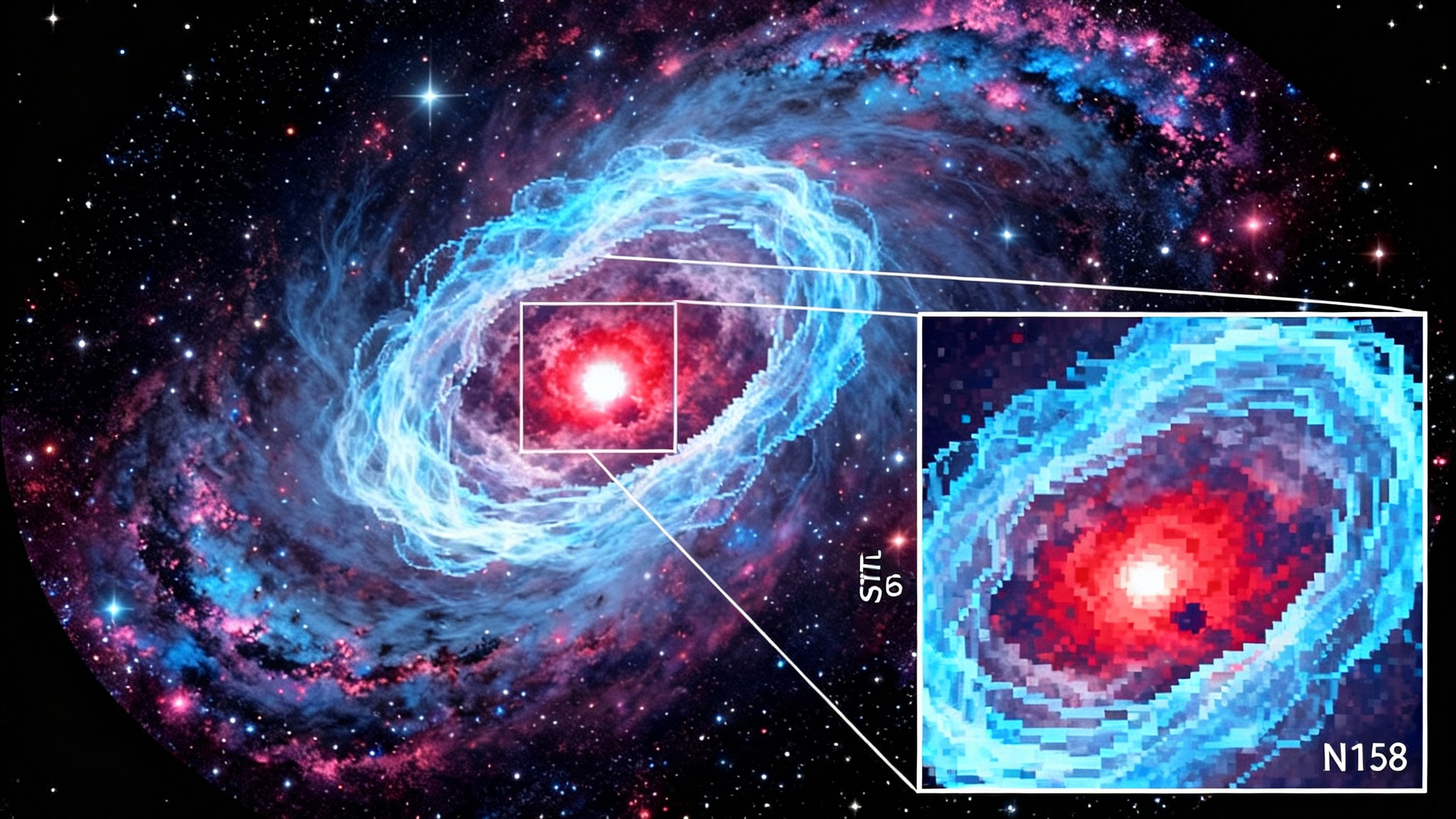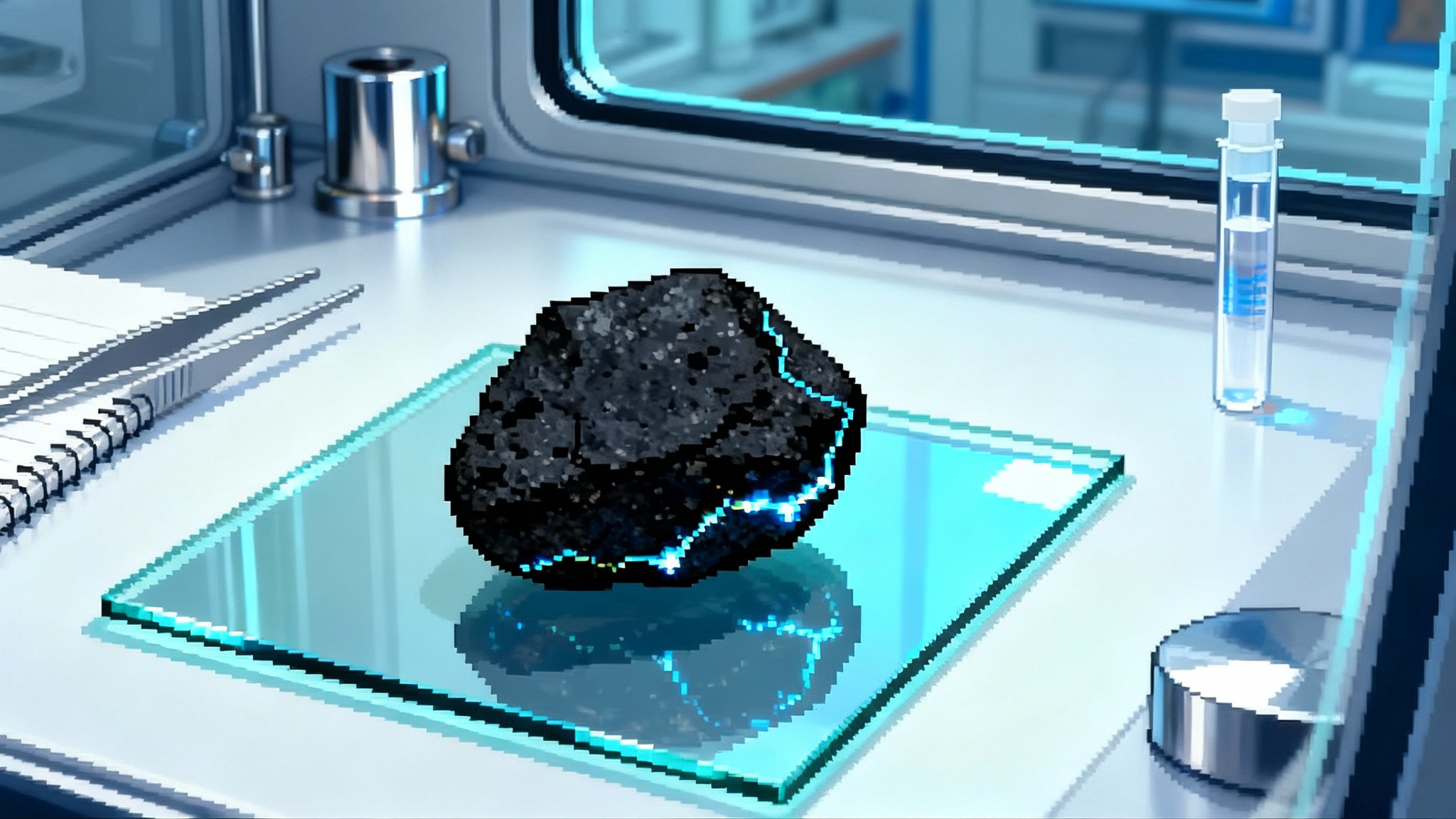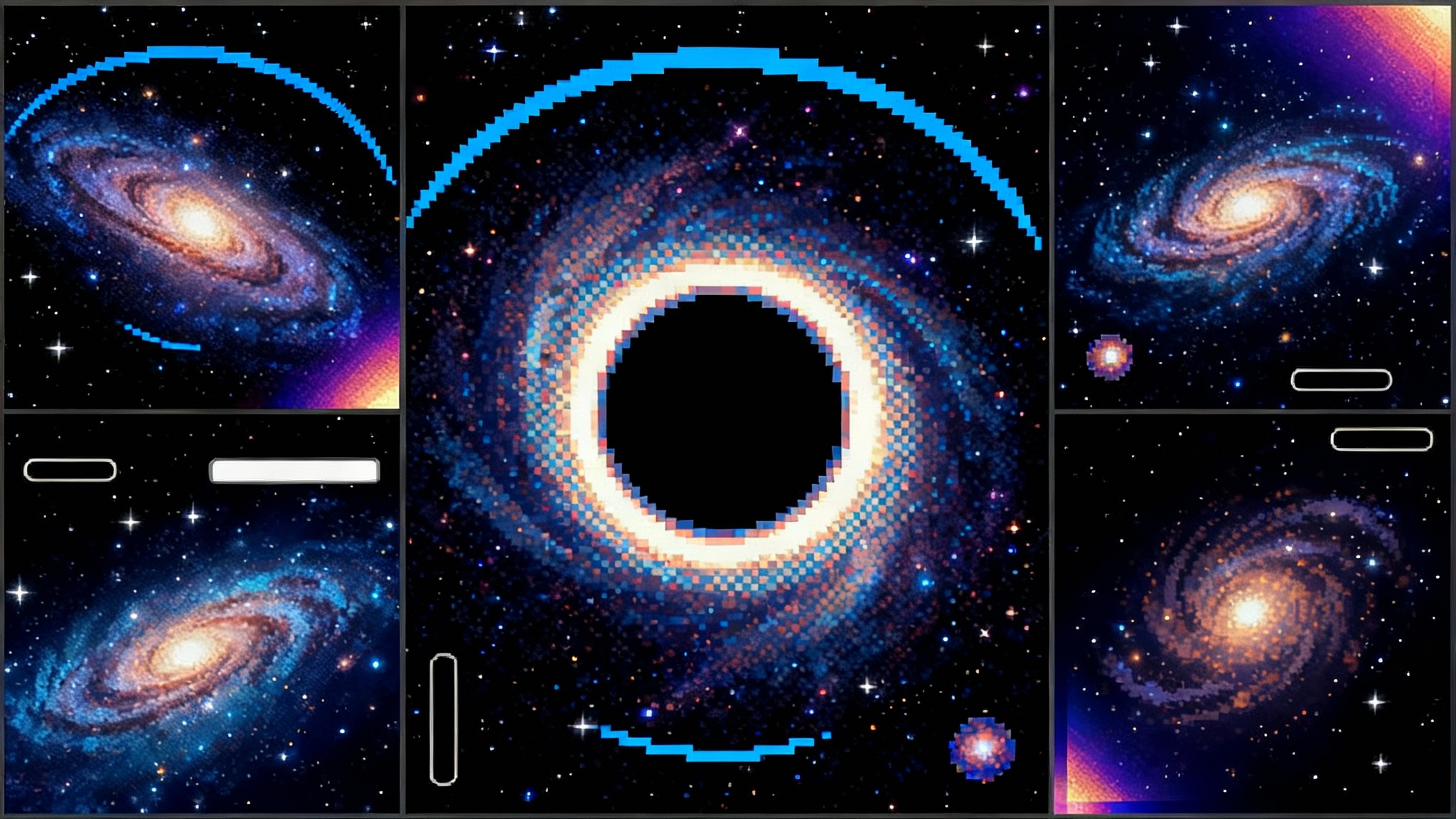Webb finds icy organics around a newborn star in the LMC
On October 20, 2025, JWST’s MIRI caught five complex organics frozen around a newborn star in the Large Magellanic Cloud, including the first secure ice detection of acetic acid. The find resets the timeline for prebiotic chemistry in harsh, low‑metallicity environments.

A newborn star, an old question
On October 20, 2025, a team led by University of Maryland astronomer Marta Sewiło reported a first-of-its-kind result. Using the Mid-Infrared Instrument aboard the James Webb Space Telescope, they detected five complex carbon-bearing molecules frozen onto dust grains around a forming star called ST6 in the Large Magellanic Cloud, our nearby dwarf galaxy companion about 160,000 light years away. The spectrum shows methanol, acetaldehyde, ethanol, methyl formate, and acetic acid. Acetic acid has never been conclusively seen in space ice before, and the others are the first secure detections of these ices outside the Milky Way. The result anchors a new era of extragalactic astrochemistry and gives us a sharper clock for when prebiotic chemistry can begin. You can read the primary analysis in the first detection of icy COMs.
ST6 sits in the N158 star-forming complex near the Tarantula Nebula, a furnace of radiation that makes this detection more surprising, not less. The Large Magellanic Cloud has fewer heavy elements than the Milky Way and a lower dust-to-gas ratio, so ultraviolet light penetrates more easily. Yet even under these harsh conditions, Webb found a pantry of complex molecules frozen on dust grains. The implication is simple and big. If a low-metallicity, high ultraviolet environment can still build and preserve such chemistry this early in a star’s life, then the universe may start the prebiotic process sooner and more often than we thought.
Why the Large Magellanic Cloud is a tough test
The Large Magellanic Cloud is a laboratory that resembles parts of the young universe. It has about one third to one half of the Sun’s metal content and less dust to shield molecules from radiation. Chemists call the detected species complex organic molecules, meaning carbon-bearing molecules with more than six atoms. These are ingredients that can lead, through many steps, to amino acids, sugars, and other biologically relevant compounds. The LMC provides a stress test for those steps. If the chemistry works there, it probably works in many more places.
In environments with fewer heavy elements, you expect thinner ice mantles, less efficient surface chemistry, and more photodestruction by ultraviolet photons. The safe bet was that simple ices like water, carbon dioxide, and carbon monoxide would dominate, with maybe a trace of methanol. Instead, Webb’s spectrum around 6 to 9 microns is rich with the signatures of more elaborate compounds. That tells us the surface reactions on dust grains are resilient. Hydrogen atoms and radicals can still hop across icy surfaces at low temperatures, and ultraviolet processing can still rearrange bonds without erasing the inventory.
Chemistry on a dust grain, in plain words
Think of a dust grain as a cold peppercorn drifting in a molecular cloud. Over time, it gathers a thin glaze of frost as water, carbon monoxide, carbon dioxide, and other molecules stick to it. In this cosmic freezer, weakly bound atoms and radicals move short distances. Imagine a crowded kitchen where the cooks can only shuffle a few inches at a time. Even with that restriction, simple recipes get cooked. Hydrogenation turns carbon monoxide into formaldehyde and then methanol. Ultraviolet photons act like tiny stir sticks, briefly energizing the ice so that fragments meet and form new bonds. That is how you can build acetaldehyde, methyl formate, ethanol, and acetic acid inside an ice mantle.
When a star ignites, its warmth carries these ices inward. Some compounds desorb into gas that telescopes like the Atacama Large Millimeter Array can detect through rotational lines. Others remain in solids that telescopes like Webb can read through mid-infrared absorption features. The key is that a significant portion of the complex chemistry is front-loaded. It happens during the cold, pre-planet phase, on grain surfaces, before planets and comets exist to inherit the inventory.
What the molecules say about time
ST6 is not building planets yet. It is a young protostar still cocooned in a 1.6 light year wide envelope of gas and dust. Finding acetic acid and ethanol frozen there means that the raw stock for prebiotic chemistry can appear very early. If these ices survive the journey into the planet-forming disk, they can be built into comets, asteroids, and later planets. On Earth, similar organics likely rode in on icy planetesimals, a theme we explored in our piece on how the Bennu sample rewrites life's recipe. Seeing the same kinds of molecules in a different galaxy means that this delivery mechanism is not a one-off. It is a cosmic pattern.
The LMC’s low metallicity matters for cosmic timing. Many galaxies in the early universe had fewer heavy elements. If complex ices can form and persist in such conditions, then prebiotic chemistry could have been widespread billions of years earlier than we assumed. That does not prove life is common. It does move the starting line forward. The scoreboard shifts from can the universe make these molecules to how often they survive the next steps, like irradiation during disk formation, shock heating during accretion, and chemical reprocessing in young atmospheres.
The decisive details in Webb’s spectrum
The ST6 spectrum spans roughly 5 to 28 microns with Webb’s mid-infrared spectrograph at medium resolution. The team fitted the data using a library of laboratory ice spectra, including mixtures where molecules are diluted in water or methanol, and at temperatures between about 10 and 100 kelvin. That matching is vital. An ethanol ice feature in pure form does not look identical when mixed into a water-rich matrix, just as a drop of food coloring looks different in syrup compared to water.
Two details deserve attention. First, acetic acid’s signature is distinctive but faint. Its secure identification in ice settles a long-standing question about whether we have simply been missing it because we lacked the sensitivity or because we lacked the right laboratory templates. Second, glycolaldehyde appears hinted at but unconfirmed. Glycolaldehyde is related to the sugar backbone in ribonucleic acid. If confirmed, it would add weight to the case that prebiotic pathways have a head start even in hard radiation fields.
For readers who want a non-technical summary and visual context, the project teams and the University of Maryland have packaged the main points and imagery in a concise press release with figures.
The stakes for the next 12 to 24 months
Here is what matters most in the short term. The discovery is not an endpoint. It is a pilot that shows the road is open. The next two years should focus on three coordinated pushes that together can turn one spectrum into a map of extragalactic chemistry.
1) Scale up Magellanic Cloud surveys
- What to do: Expand from a single ST6 spectrum to a statistically meaningful sample across several star-forming complexes in the Large and Small Magellanic Clouds. Target regions like N44, N79, N113, N159, N160, N83, and NGC 346. Focus on protostars at different masses and evolutionary stages. Use both medium resolution and low resolution mid-infrared spectroscopy to balance depth and breadth.
- Why it matters: We need to know whether ST6 is typical. If the abundance ratios of methanol, ethanol, methyl formate, acetaldehyde, and acetic acid vary with metallicity, ultraviolet field, or envelope mass, that tells us which environmental levers control prebiotic chemistry. If they do not vary much, that supports the idea of a robust, nearly universal chemistry.
- How to execute: Propose coordinated James Webb Space Telescope programs that share calibrations and reduction pipelines. Reserve time for mapping the diffuse background so that local continuum placement is stable. Include suitable comparison targets in the Milky Way at matched luminosities. Expect about 1 to 2 hours per target for a usable spectrum, plus overheads. A 50-object survey is therefore within the reach of one or two large programs.
2) Fill laboratory spectral gaps
- What to do: Commission a sprint of laboratory measurements of mid-infrared spectra for complex organics in mixed ices at astrophysically relevant temperatures, doses of ultraviolet irradiation, and ion processing. Prioritize acetic acid, methyl formate, ethanol, and acetaldehyde in water-rich and methanol-rich matrices. Include isotopologues to help distinguish blends. Provide absolute band strengths with uncertainties. Package the results into open, machine-readable libraries with version control.
- Why it matters: Webb’s sensitivity now exceeds the completeness of our laboratory libraries. Uncertainties in mixture effects and temperature shifts limit how precisely we can convert absorption depth into abundance. Better lab data turns ambiguous bumps into identified features and narrows the error bars on abundance ratios that feed into chemical models.
- How to execute: Funding agencies like the National Aeronautics and Space Administration, the National Science Foundation, the European Space Agency, and national research councils can pool small grants into a focused consortium that standardizes protocols and file formats. Equip a few labs with high throughput cryogenic cells, controllable ultraviolet lamps, and in situ spectrometers. Task one team with curating a shared library and a public fitting tool that mirrors what the ST6 team used.
3) Coordinate ALMA and Extremely Large Telescope follow-ups
- What to do: Use the Atacama Large Millimeter Array to search for the gas-phase counterparts of the same molecules in the warm inner envelopes of Magellanic protostars. Focus on bright rotational lines of ethanol and acetic acid in Band 6 and Band 7. Plan early for the European Southern Observatory’s Extremely Large Telescope instruments, such as METIS, that will eventually probe mid-infrared features and scattered light from disks with high angular resolution.
- Why it matters: Ice detections tell us what is locked on grains. Millimeter detections tell us what is released into gas as the protostar warms. Seeing both phases and their spatial distribution will constrain the pathways that deliver prebiotic material into planet-forming zones. Planning ELT programs now ensures that by first light we are ready with vetted targets and models.
- How to execute: Build joint proposals that share target lists and coordinate observing windows. Use Webb to benchmark the ice inventory, then trigger ALMA to capture gas phase signatures during favorable conditions. Encourage data model interoperability, so that a spectral feature selected in the mid-infrared carries metadata that helps an ALMA observer pick lines, beam sizes, and spectral resolutions without rework. For survey design inspiration across facilities, see how the SPHEREx 102-color sky atlas and the Rubin's real-time astronomy revolution align standards and cadence.
Practical takeaways for teams and funders
- Standardize the playbook: Adopt a common set of spectral windows, continuum fitting methods, and reporting formats so that measurements from different teams can be compared directly. This is a boring but high leverage step.
- Publish mixture-aware band strengths: Abundances derived from pure-ice templates can mislead. Fund the creation of mixture grids where molecules sit in water, methanol, and carbon dioxide matrices at several temperatures.
- Build a Magellanic Ice Map: Assemble a public catalog that layers ice abundances on top of maps of metallicity, ultraviolet radiation fields, and dust content. The product should be simple to explore for non-specialists and should guide proposal writers toward under-sampled regimes.
- Train a cross-discipline bench: Support fellowships that sit between laboratory spectroscopy, observational astronomy, and chemical modeling. The field’s bottleneck is often translation between communities, not telescope time.
Risks, checks, and how to avoid false confidence
Spectral confusion is real. Mid-infrared ice bands are broad, and different molecules can overlap. Matrix effects shift feature positions by tenths of a micron. That is why independent confirmations matter. A robust identification should survive changes in continuum placement, should fit multiple bands of the same molecule, and should be consistent with plausible formation pathways. For glycolaldehyde in ST6, the team notes a resemblance rather than a confirmation. That is the right level of caution and a good target for a lab campaign.
There is also the risk of overinterpreting a single object. ST6 is a bright, massive protostar, not a perfect stand-in for low mass systems like the early Sun. If future Magellanic targets show lower abundances or different ratios, that will be a feature, not a flaw. Variation across environments is the data we need to connect chemistry to conditions.
What this changes for the search for life
No one should confuse prebiotic molecules with biology. But the discovery shifts expectations about when and where life-friendly chemistry can start. It supports a picture in which dust grains in cold clouds act as slow, patient reactors. They hand off complex ices to disks, which incorporate them into comets and planetesimals, which later deliver them to growing planets. The LMC result says this chain can operate even where the raw materials are scarce and the ultraviolet light is harsh.
For exoplanet research, the implication is immediate. When the next generation of telescopes takes spectra of young planetary atmospheres and disks, modelers can assume richer starting inventories, even in galaxies with fewer heavy elements. That changes predictions for the volatile budgets of rocky worlds and for the kinds of molecules that might appear in outgassed atmospheres.
A grounded, slightly accelerationist case
This is a moment to speed up with intent. The field does not need a moonshot. It needs well-coordinated sprints. The observations are within reach today. The laboratory work requires modest instrumentation and tight collaboration. The modeling benefits from clean, shared datasets more than from heroic algorithms. If agencies and observatories align proposals, data standards, and lab support, we can turn a single extragalactic detection into a map of how prebiotic chemistry spreads through the cosmos.
The business case is strong for the institutions involved. The Space Telescope Science Institute and the National Aeronautics and Space Administration can showcase Webb’s unique reach beyond photogenic images, into measurements that touch the origin of life. The European Southern Observatory and the Atacama Large Millimeter Array can demonstrate how their facilities complete the picture by tracing the gas-phase aftermath. Universities can recruit across chemistry and astronomy with a clear scientific narrative and fast feedback cycles.
The payoff
A newborn star in a neighboring galaxy now carries a list of molecules we associate with kitchens, labs, and life. Vinegar’s key ingredient. A familiar alcohol. A whiff of sweet esters and aldehydes. In the cold and the dark, on grains smaller than smoke particles, the universe is already mixing ingredients. The clock for prebiotic chemistry starts earlier than we expected, and it does not seem to care much about a galaxy’s metal budget.
In the next two years, we can test how widespread that clock is. A larger Webb survey across the Magellanic Clouds, a focused push on laboratory spectra, and synchronized millimeter follow-ups will either show that ST6 is an outlier or that it is a preview. Either outcome is a win. One sharpens our theories. The other redraws our expectations for where and when life’s chemistry can begin. Either way, the path from ice to insight is open, and the best move now is to walk it briskly, together.








